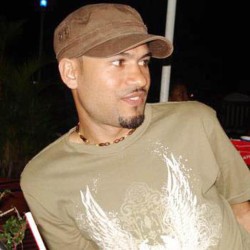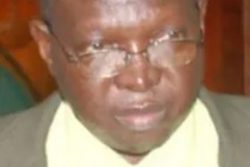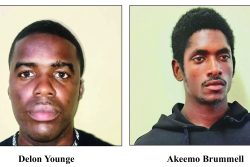A number of Guyanese plays that began to develop after 1981 belonged to the period of the popularisation of drama in Guyana and the rise of a new, popular and populous audience for theatre. This means the plays needed, and in fact were shaped by, an appeal to a larger mass audience. During the 1980s and after, therefore, there was the rise of the popular play in Guyana. The comic appeal was foremost, but there was also sensational intrigue and plays that drew upon grassroots interests and on immediate topical issues.
 Some of the more successful of these generated such a box office demand that they were repeated in re-runs over the last 30 years. We have in the recent past listed the highest ranking among these plays in terms of popularity, including those that have been the most repeated or brought back.
Some of the more successful of these generated such a box office demand that they were repeated in re-runs over the last 30 years. We have in the recent past listed the highest ranking among these plays in terms of popularity, including those that have been the most repeated or brought back.
Leading Guyanese playwright Ronald Hollingsworth is the author of more than one play on that list. He even holds the distinction of having written and produced what is probably the most popular and most demanded of those; that is the steamy, rollicking comedy Till Ah Find A Place. Such was its impact, that it prompted a series of sequels. One of these, Till Ah Find A Place 3: She’s Back also claimed a place on the most popular list. It had its most recent reincarnation in 2014, directed by Sheron Cadogan-Taylor and won the major award in the 2014 National Drama Festival. Just to repeat, the most popular list includes:

Till Ah Find A Place (Hollingsworth);
Anybody See Brenda? (Paloma Mohamed);
Watch De Ride (Hollingsworth);
Till Ah Find A Place 3: She’s Back (Hollingsworth);
Two’s A Crowd (Ian Valz)
Diplomatic Blow

Diplomatic Blow was first produced in the 1990s – the Programme Notes say 1992 – in Hollingsworth’s early career when he was seizing opportunities to exploit topical issues, the sensational and laughter. This was all in keeping with the developing trends in Guyanese theatre at the time, following Harold Bascom’s forging out into “mirror plays” reflecting the grassroots and appealing to the new popular audience. It is not surprising that such a theatre was one of social realism, and that is the form that still dominates in Guyana today.
Diplomatic Blow is still riding on that wave of popularity and was brought back to exploit the market. It was directed by Cadogan-Taylor and Hollingsworth with what might be a few alterations to the original script. One of the things that make it possible for some of these plays to be forever repeated is not only the usual “brought back by popular demand” claim. It is the fact that the better plays, however popular and hilarious, have something to say to the audience – something that would still command interest 20 or 25 years later; that they can stand the scrutiny of time. Two’s A Crowd is not very strong in this department.
Interestingly, Diplomatic Blow is not in the strictest of categories, a popular play – it is social realism and in 1992, was striking the hot iron of the Guyanese visa culture. It touched the impact of demand for the mighty and obsessively desired US visa in the local society. But it also drew on the intrigue, curiosity, prestige and awe surrounding life in the diplomatic community in a third world country like Guyana. It is a strength of the play that those topics have not outlived their time after so many years and can still keep an audience interested. In addition, the drama increases its appeal by dealing with the timeless theme of sex and to give it extra edge, sex in the community of the embassies. Scandals involving the selling of visas are also thrown in for extra measure as a plausible sub-plot.
However, while it is not among the deep plays, it also attempts to comment on a number of other social and human issues. Hollingsworth has long ago developed into a solid, consistent writer and director with a high place in Guyanese drama. This was underscored by the fact that, in collaboration with Cadogan-Taylor, his plays won the National Drama Festival for the past three consecutive years. So that, while taking advantage of popular appeal, the play makes some useful commentary.
In this new version of the play, Vishnu Singh, a not so committed university student played by Mark Kazim, finds himself fortuitously in the depths of the diplomatic circle. The drama plays on ironies and central to the plot and its statement, is that while Singh might have landed himself in the depths of a diplomat’s bed, his presence there was next to invisible, since he was merely like flotsam skimming on the surface of the pool. While he flatters himself about his new-found power and status, it was all superficial because the American Embassy official played by Leslyn Bobb-Semple has picked him up to entertain her lust temporarily and superficially, ready to dump him as she wishes.
The play teaches Singh quite a lesson, since he fails the tests for success. Central to this is his shabby treatment of his loyal and faithful fiancée Kavita Persaud played by both Nirmala Narine and Sonia Yarde. He also ceases to value deep friendships such as that of his flat-mate Nigel (Sean Thompson) while he suffers the role of the cowed and conquered just where he thought he had made a conquest.
While the play may be regarded as fairly light with an emphasis on the intrigue, the sensation and the humour, its strengths may be found in how it handles the social implications of Singh’s deception, his so-called rise, and inevitable fall. But its most outstanding feature is the power of its performance. It is played on a well-used and functional set with extremely tight stage management led by Nicola Moonsammy, a graduate of the National School of Theatre Arts and Drama, who has developed as a professional in stage management on the national stage.
The production also demonstrates the high competence of Cadogan-Taylor as a director, who, in collaboration with Hollingsworth, led the creation of the production which was strong in stage use, pace, character creation and acting. It is another achievement for her. The performance of the leads helped to define characterisation and carry the nuances of plot. Bobb-Semple managed a
convincing speech, mannerisms and body language for the three main roles that she had. She moved easily between the lust and the calm indulgence of her love affair. At the same time, she commanded the femme fatale who toyed with her victim, turning him into an errand boy and cold-bloodedly designing his destruction. Yet she was an appropriately different creature in her exchanges with her partner in crime, her fellow visa officer played by Alana Craigen. In a minor role, Craigen was on top of the requirements for the part in both the lust and the efficient plotter of skullduggery.
Kazim was able to play for the laughter as well as for the major ironies in the play. Opposite Bobb-Semple he helped to make the roles clear in very effective dramatisation. His achievement was similar in two other areas – his life of puffed-up boastfulness with his friend Nigel (Sean Thompson) and superficiality in dealing with Kavita were all understood by the actor. Also well played was his battle with the domestic help (Clemencio Godette). What was not so memorable was his playing of pathos. He did not draw on too many superior resources in capturing the emotions accompanying his rapid decline after Diane dropped the guillotine.
What was memorable, superior and drew on consistently effective resources was the character role of the domestic as portrayed by Goddette. The playwright gave her a bit too much soliloquising, which tends to be undramatic, but Goddette rose above it thoroughly in her creation of a credible personality. She managed to hold it consistently in all the different situations through which she took the role. Goddette made an impact and turned it into a major factor in the play.
There was little difference in the way Nirmala Narine and Sonia Yarde in turn, delivered the part of Kavita. They both did what was required and contributed as much as the others to the high standard of performance quality in the production. Even the minor roles played by Carollene Leza Singh and Paul Budnah helped to lend the play its uniform performance power.
And that included Sean Thompson who could move from the braggadocio of his carousing with his friend to compassion in his attitude to Kavita and the offering to the audience of an alternative to Vishnu Singh. This alternative strengthened the play and Thompson understood it in such a way that there was total clarity and dramatic force in the presentation.
There was no mediocre acting anywhere in a production so complete it covered up what weaknesses there are in the script.







